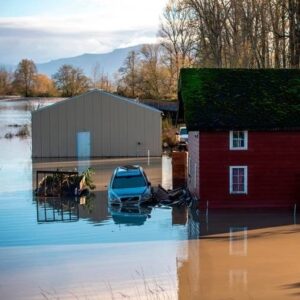 Battered by super-wet “atmospheric rivers” coming in from the Pacific Ocean, western Washington is once again dealing with overflowing rivers, flooded streets and homes, and people needing rescue.
Battered by super-wet “atmospheric rivers” coming in from the Pacific Ocean, western Washington is once again dealing with overflowing rivers, flooded streets and homes, and people needing rescue.
More or less happens every winter, although it’s unusually severe this time, because of extreme weather (see story here).
In his book (get it here), King of Fish, Prof. David Montgomery of the University of Washington describes what the Pacific Northwest was like before white settlers began arriving in large numbers in the early 1850s.
Basically, a land of rivers choked with fallen trees, and lowlands flooded by winter rains. As time went on, the rivers were cleared of logs to make them navigable, and the wet lowlands were turned into farms.
That was terrible for fish, but nobody at the time realized it, or much cared, because the fish were so abundant that everyone assumed they were an inexhaustible resource and would last forever. (They were wrong.)
Most people in these parts think salmon spawn in rivers, and the damming of the Pacific Northwest’s rivers decimated the salmon runs. (Today’s Columbia River salmon runs have only 1% to 2% as many fish as the historic runs.) That’s mostly untrue.
The video below (filmed in 2016) gives you a clue. The flooded lowlands, not the rivers, were the vast “salmon factories” where fish spawned and produced hundreds of millions of smolts. You still see a few of these fish today, making their way across fields and roads, during the region’s wet months. But in historic times, a place like this would’ve been covered with spawning salmon in unimaginable numbers.
So it wasn’t the dams that destroyed this great natural resource, which was mostly gone by the early 1900s decades before the first dams were built. It was the clearing of the river logjams, the draining of the swampy lowlands to turn them into farmland, and commercial overfishing in the 1890s.
The overfishing resulted from two signal events after the Civil War: The invention of canning and the construction of transcontinental railroads, which together enabled salmon to be preserved and shipped to eastern markets, opening a vast market for them. This led to the appearance of huge fishing fleets and numerous coastal canneries, and thoughtless overexploitation of the resource.
Salmon, by the way, is a very ancient species. They’ve been around for 50 or 60 million years, evolving with the changing physical landscape, and remarkable for their toughness, resiliency, and ability to quickly recolonize streams destroyed by lava flows or forest fires.
We can keep them, if we give them half a chance. But they’re competing against commercial development, which encroaches on the natural systems they need to reproduce. People won’t turn back the clock. They won’t reconvert farms to natural salmon hatcheries. But nature might if climate change accelerates. We conceivably might get to a point where there’s so much water that no amount of human engineering can hold it back anymore. We’ll see.